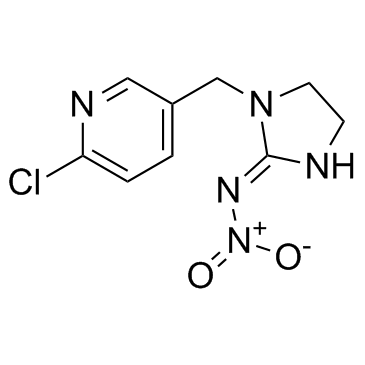Imidacloprid |
| Catalog No.GC30895 |
A neonicotinoid insecticide
Products are for research use only. Not for human use. We do not sell to patients.

Cas No.: 138261-41-3
Sample solution is provided at 25 µL, 10mM.
Imidacloprid is an effective and widely used neonicotinoid pesticide to control pests of cereals, vegetables, tea and cotton.
Insulin stimulated glucose uptake is reduced by imidacloprid in adipocytes (3T3-L1), hepatocytes (HepG2), and myotubes (C2C12) cell culture models. Treatment with imidacloprid reduced phosphorylation of protein kinase B (AKT), one of the major regulators of insulin signaling, without changing overall AKT expression. imidacloprid reduced phosphorylation of ribosomal S6 kinase (S6K), which is a downstream target of AKT and also a feed-back inhibitor of insulin signaling[1].
Imidacloprid in high doses causes deterioration in cognitive functions particularly in infant rats, and this deterioration may be associated with changes in the expressions of related genes. Learning activities are diminished significantly at 2 and 8 mg/kg doses in the infant model groups and at 8 mg/kg dose in adult rats. Also, expression levels of GRIN1, SYP and GAP-43 are found to be insignificantly altered[2]. Early developmental exposure to imidacloprid has both early-life and persisting effects on neurobehavioral function in zebrafish. In larvae, developmental imidacloprid exposure at both doses significantly decreased swimming activity. In adolescent and adult fish, developmental exposure to imidacloprid significantly decreased novel tank exploration and increased sensorimotor response to startle stimuli[3]. Decrease in the body weight gain is observed at 20 mg/kg/day and at necropsy the relative body weights of liver, kidney and adrenal is also significantly increased at this dose level. The spontaneous locomotor activity is also decreased at highest dose exposure where as there are no significant changes in hematological and urine parameters. The brain, liver and kidney of rats exposed with high dose of imidacloprid has showed mild pathological changes[4]. Imidacloprid at 20 mg/kg has produced significant changes in SOD, CAT, GPx, GSH, LPO in liver; SOD, CAT, and GPx in brain and LPO in kidney[5]. Imidacloprid at high dose, specifically suppresses cell-mediated immune response as is evident from decreased DTH response and decreased stimulation index of T-lymphocytes to PHA. Prominent histopathological alterations are also observed in spleen and liver. Histopathological analysis of footpad sections of mice reveal dose-related suppression of DTH response[6].
[1]. Kim J, et al. Imidacloprid, a neonicotinoid insecticide, induces insulin resistance. J Toxicol Sci. 2013;38(5):655-60. [2]. Kara M, et al. Insecticide imidacloprid influences cognitive functions and alters learning performance and related gene expression in a rat model. Int J Exp Pathol. 2015 Oct;96(5):332-7. [3]. Crosby EB, et al. Neurobehavioral impairments caused by developmental imidacloprid exposure in zebrafish. Neurotoxicol Teratol. 2015 May-Jun;49:81-90. [4]. Bhardwaj S, et al. A 90 days oral toxicity of imidacloprid in female rats: morphological, biochemical and histopathological evaluations. Food Chem Toxicol. 2010 May;48(5):1185-90. [5]. Kapoor U, et al. Effect of imidacloprid on antioxidant enzymes and lipid peroxidation in female rats to derive its No Observed Effect Level (NOEL). J Toxicol Sci. 2010 Aug;35(4):577-81. [6]. Badgujar PC, et al. Immunotoxic effects of imidacloprid following 28 days of oral exposure in BALB/c mice. Environ Toxicol Pharmacol. 2013 May;35(3):408-18.
Average Rating: 5 (Based on Reviews and 12 reference(s) in Google Scholar.)
GLPBIO products are for RESEARCH USE ONLY. Please make sure your review or question is research based.
Required fields are marked with *




















